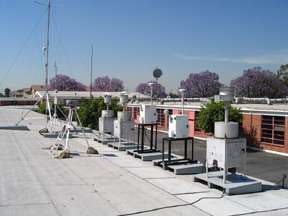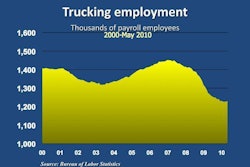
The Port of Los Angeles announced that the 2009 Inventory of Air Emissions associated with its cargo handling operations shows diesel particulate matter emissions dropped by 37 percent from 2008, nitrogen oxide (NOx) emissions fell 28 percent and sulfur oxide (SOx) emissions were down 36 percent. When comparing 2009 emissions to 2005 emissions, the reductions are even more dramatic: 52 percent for DPM, 33 percent for NOx and 56 percent for SOx.
On an emissions-per-10,000 Twenty-Foot Equivalent (20-foot containers or “TEU”) basis, which accounts for recession-related decreases in cargo volumes, the drop in emissions also is significant. Between 2005 and 2009, particulate matter emissions, including DPM, PM2.5 and PM10, dropped by 47 percent, while NOx fell 26 percent and SOx dropped 51 percent in the same five-year period. In the last year alone, DPM, PM2.5 and PM10 each experienced a 26 to 27 percent drop using the per-unit-of-cargo measure. DPM is an identified toxic air contaminant and known carcinogen. NOx and SOx are key components of smog.
“We are extremely pleased to see how effective the Clean Air Action Plan has been,” says Port Executive Director Geraldine Knatz. “Even with recession-related cargo declines factored in, we saw very positive year-over-year emissions reductions in 2009. The results show that the investments the port and its customers have made in cleaner operations are delivering a healthy payoff.”
Pollutant emissions on a per-unit-of-cargo basis are a key target of the San Pedro Bay Ports Clean Air Action Plan. When it adopted the CAAP in 2006, the port pledged not only to reduce overall emissions but also to make sure that each ton of cargo would be moved with fewer emissions in coming years; that way, even if cargo volumes continue to rise, total port-related air pollution should decline over time.
The CAAP’s goals for 2014 include cutting port-related DPM emissions by 72 percent, NOx emissions by 22 percent and SOx emissions by 93 percent below 2005 levels; further decreases are targeted by 2023. The CAAP goals are tied closely into the South Coast Air Quality Management District’s plan to meet federal air quality standards.
“We’re definitely on track to meet the Clean Air Action Plan’s Bay-wide standards – our long-term air quality goals,” say Christopher Patton, the port’s acting assistant director of environmental management. “In fact, in five years we’ve come more than halfway towards our 10-year target for DPM and SOx emissions reductions, and we are striving to continue to exceed our target for NOx. As we continue to apply the CAAP’s existing and new control measures, we expect the reduction trend to continue in 2010.”










